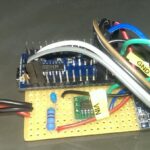The Obdii P1133 code, often a cause of concern for vehicle owners, indicates a problem within the oxygen sensor circuit of your car. Specifically, it signals a “Heated Oxygen Sensor Circuit Slow Response (Bank 1, Sensor 1).” Understanding what this means and how to address it is crucial for maintaining your vehicle’s performance and fuel efficiency.
Decoding the P1133 Code: Oxygen Sensor Explained
To grasp the P1133 code, it’s essential to understand the role of oxygen sensors in your vehicle’s emission control system. Oxygen sensors, also known as O2 sensors or lambda sensors, are vital components that monitor the oxygen levels in your exhaust gases. This information is relayed to the engine control unit (ECU) or powertrain control module (PCM), which then adjusts the air-fuel mixture to ensure optimal combustion and reduce harmful emissions.
Bank 1, Sensor 1 refers to the upstream oxygen sensor located before the catalytic converter on the side of the engine where cylinder number 1 is situated. This sensor plays a critical role in providing feedback for fuel trim adjustments. “Slow response” indicates that the sensor is not reacting quickly enough to changes in the exhaust gas composition, as expected by the PCM.
Common Symptoms Associated with a P1133 Code
While the check engine light illuminating is the most obvious sign, other symptoms can accompany the P1133 code, including:
- Decreased Fuel Economy: An improperly functioning oxygen sensor can lead to an imbalanced air-fuel mixture, often resulting in the engine running richer than necessary and consuming more fuel.
- Rough Idle or Stalling: In some cases, a slow-responding oxygen sensor can contribute to engine performance issues, manifesting as a rough idle or even stalling, particularly at lower speeds.
- Failed Emissions Test: Due to the impact on exhaust emissions, a P1133 code can cause your vehicle to fail an emissions test.
- Hesitation During Acceleration: The engine might hesitate or feel sluggish when accelerating if the air-fuel mixture is not correctly adjusted due to a faulty sensor signal.
Potential Causes of the OBDII P1133 Code
Several factors can trigger the P1133 code. Pinpointing the exact cause is the first step towards effective repair. Common culprits include:
- Faulty Oxygen Sensor: The sensor itself might be degrading or malfunctioning due to age, contamination, or electrical damage. This is the most frequent cause.
- Wiring and Connector Issues: Problems within the oxygen sensor circuit, such as damaged wiring, loose connections, corrosion, or shorts, can impede the sensor’s signal transmission to the PCM.
- Exhaust Leaks: Leaks in the exhaust manifold or exhaust system before the oxygen sensor can introduce extra air, skewing the sensor readings and triggering the P1133 code.
- Vacuum Leaks: Vacuum leaks in the intake manifold or vacuum lines can also affect the air-fuel mixture, indirectly impacting oxygen sensor readings.
- Contaminated or Clogged Sensor: The oxygen sensor can become contaminated by oil leaks, coolant leaks, or excessive carbon deposits, leading to slow response times.
- PCM Issues (Less Common): In rare instances, a fault within the PCM itself could misinterpret sensor signals or incorrectly trigger the P1133 code.
Diagnosing and Repairing the P1133 Code
Troubleshooting the P1133 code requires a systematic approach. Here are steps you or a qualified mechanic can take:
-
Visual Inspection: Begin by carefully inspecting the oxygen sensor, its wiring, and connectors for any signs of damage, looseness, or corrosion. Check for exhaust leaks near the sensor and vacuum leaks around the intake manifold.
-
Scan Tool Data Analysis: Use an OBDII scan tool to read the live data stream from the oxygen sensor. Analyze the sensor’s voltage readings and response time to determine if it is reacting as expected. Compare readings with specifications for your vehicle.
-
Oxygen Sensor Testing: A multimeter can be used to test the oxygen sensor’s heater circuit resistance and signal voltage. This can help determine if the sensor itself is faulty. Refer to your vehicle’s service manual for specific testing procedures and values.
-
Wiring Circuit Testing: If the sensor appears to be functioning, test the wiring circuit between the sensor and the PCM for continuity, shorts, and proper voltage.
-
Smoke Test for Leaks: A smoke test can effectively identify vacuum and exhaust leaks that might be contributing to the P1133 code.
-
Sensor Replacement: If the oxygen sensor is determined to be faulty, replacement is usually necessary. Ensure you use the correct type of oxygen sensor for your vehicle’s make and model.
-
PCM Diagnosis (If Necessary): If all other components check out and the P1133 code persists, PCM issues might be suspected. This usually requires advanced diagnostic tools and expertise.
Conclusion
The OBDII P1133 code points to a slow response issue with your upstream oxygen sensor (Bank 1, Sensor 1). Addressing this code promptly is important for maintaining optimal engine performance, fuel economy, and emissions control. By understanding the potential causes and following a systematic diagnostic approach, you can effectively troubleshoot and resolve the P1133 code, ensuring your vehicle runs smoothly and efficiently. If you’re not comfortable performing these diagnostic steps yourself, consulting a certified mechanic is always recommended for accurate diagnosis and repair.

